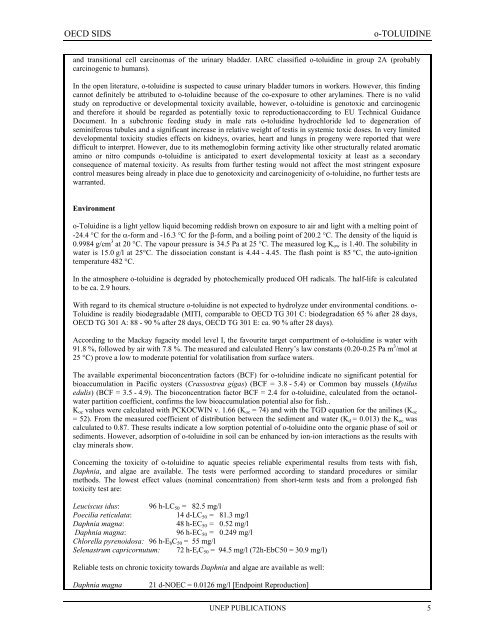o-TOLUIDINE CAS N°: 95-53-4 - UNEP Chemicals
o-TOLUIDINE CAS N°: 95-53-4 - UNEP Chemicals
o-TOLUIDINE CAS N°: 95-53-4 - UNEP Chemicals
Create successful ePaper yourself
Turn your PDF publications into a flip-book with our unique Google optimized e-Paper software.
OECD SIDS o-<strong>TOLUIDINE</strong><br />
and transitional cell carcinomas of the urinary bladder. IARC classified o-toluidine in group 2A (probably<br />
carcinogenic to humans).<br />
In the open literature, o-toluidine is suspected to cause urinary bladder tumors in workers. However, this finding<br />
cannot definitely be attributed to o-toluidine because of the co-exposure to other arylamines. There is no valid<br />
study on reproductive or developmental toxicity available, however, o-toluidine is genotoxic and carcinogenic<br />
and therefore it should be regarded as potentially toxic to reproductionaccording to EU Technical Guidance<br />
Document. In a subchronic feeding study in male rats o-toluidine hydrochloride led to degeneration of<br />
seminiferous tubules and a significant increase in relative weight of testis in systemic toxic doses. In very limited<br />
developmental toxicity studies effects on kidneys, ovaries, heart and lungs in progeny were reported that were<br />
difficult to interpret. However, due to its methemoglobin forming activity like other structurally related aromatic<br />
amino or nitro compunds o-toluidine is anticipated to exert developmental toxicity at least as a secondary<br />
consequence of maternal toxicity. As results from further testing would not affect the most stringent exposure<br />
control measures being already in place due to genotoxicity and carcinogenicity of o-toluidine, no further tests are<br />
warranted.<br />
Environment<br />
o-Toluidine is a light yellow liquid becoming reddish brown on exposure to air and light with a melting point of<br />
-24.4 °C for the α-form and -16.3 °C for the β-form, and a boiling point of 200.2 °C. The density of the liquid is<br />
0.9984 g/cm 3 at 20 °C. The vapour pressure is 34.5 Pa at 25 °C. The measured log Kow is 1.40. The solubility in<br />
water is 15.0 g/l at 25°C. The dissociation constant is 4.44 - 4.45. The flash point is 85 °C, the auto-ignition<br />
temperature 482 °C.<br />
In the atmosphere o-toluidine is degraded by photochemically produced OH radicals. The half-life is calculated<br />
to be ca. 2.9 hours.<br />
With regard to its chemical structure o-toluidine is not expected to hydrolyze under environmental conditions. o-<br />
Toluidine is readily biodegradable (MITI, comparable to OECD TG 301 C: biodegradation 65 % after 28 days,<br />
OECD TG 301 A: 88 - 90 % after 28 days, OECD TG 301 E: ca. 90 % after 28 days).<br />
According to the Mackay fugacity model level I, the favourite target compartment of o-toluidine is water with<br />
91.8 %, followed by air with 7.8 %. The measured and calculated Henry’s law constants (0.20-0.25 Pa m 3 /mol at<br />
25 °C) prove a low to moderate potential for volatilisation from surface waters.<br />
The available experimental bioconcentration factors (BCF) for o-toluidine indicate no significant potential for<br />
bioaccumulation in Pacific oysters (Crassostrea gigas) (BCF = 3.8 - 5.4) or Common bay mussels (Mytilus<br />
edulis) (BCF = 3.5 - 4.9). The bioconcentration factor BCF = 2.4 for o-toluidine, calculated from the octanolwater<br />
partition coefficient, confirms the low bioaccumulation potential also for fish..<br />
Koc values were calculated with PCKOCWIN v. 1.66 (Koc = 74) and with the TGD equation for the anilines (Koc<br />
= 52). From the measured coefficient of distribution between the sediment and water (Kd = 0.013) the Koc was<br />
calculated to 0.87. These results indicate a low sorption potential of o-toluidine onto the organic phase of soil or<br />
sediments. However, adsorption of o-toluidine in soil can be enhanced by ion-ion interactions as the results with<br />
clay minerals show.<br />
Concerning the toxicity of o-toluidine to aquatic species reliable experimental results from tests with fish,<br />
Daphnia, and algae are available. The tests were performed according to standard procedures or similar<br />
methods. The lowest effect values (nominal concentration) from short-term tests and from a prolonged fish<br />
toxicity test are:<br />
Leuciscus idus: 96 h-LC50 = 82.5 mg/l<br />
Poecilia reticulata: 14 d-LC50 = 81.3 mg/l<br />
Daphnia magna: 48 h-EC50 = 0.52 mg/l<br />
Daphnia magna: 96 h-EC50 = 0.249 mg/l<br />
Chlorella pyrenoidosa: 96 h-EbC50 = 55 mg/l<br />
Selenastrum capricornutum: 72 h-ErC50 = 94.5 mg/l (72h-EbC50 = 30.9 mg/l)<br />
Reliable tests on chronic toxicity towards Daphnia and algae are available as well:<br />
Daphnia magna 21 d-NOEC = 0.0126 mg/l [Endpoint Reproduction]<br />
<strong>UNEP</strong> PUBLICATIONS 5
















